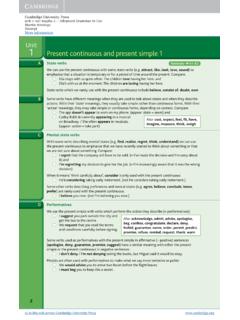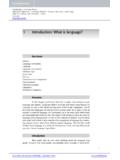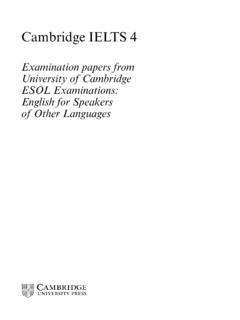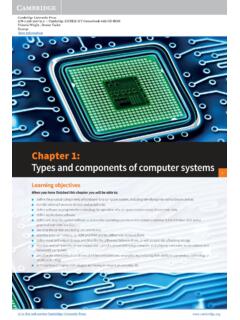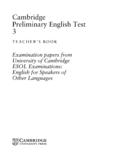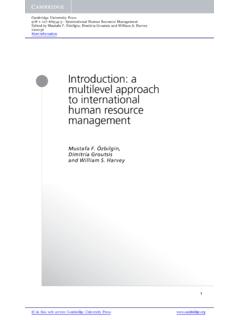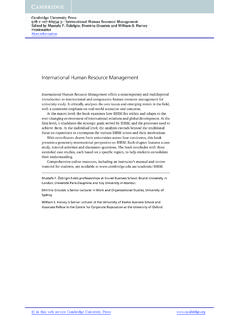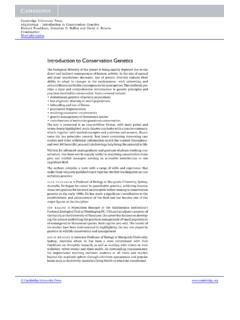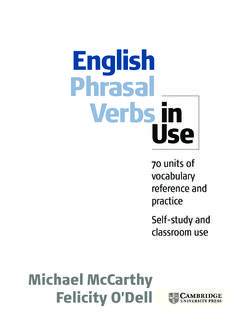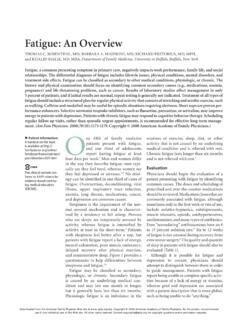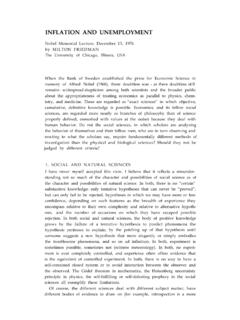Transcription of Pronunciation Practice Activities - Cambridge University Press
1 PronunciationPractice ActivitiesA resource book for teaching English pronunciationMartin Hewingspublished by the Press syndicate of the University of cambridgeThe Pitt Building, Trumpington Street, Cambridge , United Kingdomcambridge University pressThe Edinburgh Building, Cambridge cb2 2ru, UK40 West20th Street, New York, ny 10011 4211, USA47 7 Williamstown Road, Port Melbourne, vic 3207, AustraliaRuiz de Alarc n 13 , 28 014 Madrid, SpainDock House, The Waterfront, Cape Town 8001, South Cambridge University Press 2004 This book is in copyright, which normally means that no reproductionof any part may take place without the written permission ofCambridge University Press . The copying of certain parts of it byindividual teachers for use in classrooms, however, is hereby permittedwithout such formality. To aid identification, Activities which arecopiable by the teacher without further permission are identified by aseparate copyright notice: Cambridge University Press published 2004 Printed in the United Kingdom at the University Press , CambridgeTypeface:Adobe Sabon 10/13ptSystem:QuarkXPress [se]A catalogue record for this book is available from the British LibraryLibrary of Congress Cataloguing in Publication data applied forisbn 0 521 75457 7packContentsAcknowledgementsxIntroducti on1 Aims1 Organisation1 What is Pronunciation ?
2 3 Key issues in Pronunciation teaching and learning10 Activities231 Developing awareness of English features of you thinking: a Pronunciation vowel clusters: English and first slow and quick names in places, products and in print382 Sounds: vowels, consonants and consonant clusters42 Vowels: correcting particular vowel sounds: a family words including the same vowel sound: word and saying differences between vowels and betweenconsonants: minimal with single vowel words according to their first vowel61vConsonants: correcting particular lives where? Minimal pair words according to their first rid of unwanted vowels71 Consonant cluster towers773 Connected speech79 Links between adjectives and nouns: consonant to vowel sounds: consonant to consonant the linking sounds: vowels linked with /j/ (y) and / opposites and words that go together: vowelslinked with /r/85 Contracted about speech and writing91 Weak and strong forms of grammar weak and strong weak and strong to weak forms98 Leaving out out consonants: /t/ and /d/ in out vowels in words1014 Syllables, word stress and stress in phrases10 3 Syllables10 many syllables?
3 10 same or different number of syllables?10 words10 5 ContentsviWord stress10 syllable length10 words with their stress patterns10 the words10 names10 the patterns in -tyand-teennumbers (1): patterns in -tyand-teennumbers (2): talking in noun verb of word stress in two-syllable nouns, adjectives and verbs12 0 Stress and word of word stress: prefixes and and word stress: words ending and word stress: words ending in phrasal verbs and related of stress in compound nouns131 Stress in or different stress patterns? your shift in nationality shift in compounds1395 Intonation142 Prominence: highlighting words and prominent and non-prominent words: James Bond and saying prominent words: They re on the table contrasts within words: stalactitesandstalagmites147 Tone units and tonic speech into tone word placement: At ten to seven, or ten to eight?
4 15 3 ContentsviiTones15 tones: fall or rise?15 choice in questions15 and falling-rising tones: reservation16 News and not news : correcting16 16 Pronunciation and other parts of language: spelling,grammar and vocabulary16 5 Pronunciation and spelling16 English alphabet letters16 single vowel letters (1)16 single vowel letters (2)16 pairs of vowel letters: OU,OA,OE,OI,OO17 consonant letters: CandG17 consonant pairs: PH,CH,SH,THandGH17 : a row about rowing?17 7 Pronunciation and grammar17 plurals, verbs and possessives17 past tense verbs18 1 Pronunciation and vocabulary18 words18 one out18 pronunciations18 57 Testing pronunciation18 evaluation of pronunciation18 particular problems18 vowels and consonants19 weak and contracted forms19 word tone2098 Resources for Pronunciation teaching213 Using a out about word out about secondary stress.
5 Shifting stress215 ContentsviiiUsing phonetic out about sounds and words218 Using authentic Knock, knock with features of connected texts showing features of pronunciation228 Web-based resources231 Appendix 1 Key to phonetic symbols232 Appendix 2 Common Pronunciation problems233 Appendix 3 Initial consonant clusters in English239 Appendix 4 Some word stress rules240 Bibliography242 Index244 Contentsix1 Developing awareness of Introducing features of pronunciationThis activity introduces some key terms (vowel, consonant,consonant clusters, word stress and intonation) and gets studentsthinking about differences between Pronunciation in English andtheir first Pronunciation termsLevelElementaryTime20 30minutesPreparationCopy the material in Box 1onto a a copy of the handout to each student and ask them to look at thesection on the examples in 1.
6 Say the words and explain that vowel soundsare do the exercise in 2and check the students some time to think about the question in 3. They shouldtalk about their answers to a partner or other students in a small group.(In a multilingual class, students in each pair/group should have differentfirst languages if possible.)5 Finally, discuss the answers with the class as a whole. Highlight similaritiesand differences between English and the students first languages, andcheck that students have understood the key term (vowel) the procedure for each of the key terms. Note that in the sectionon intonation, you will need to demonstrate the tones (fall, rise, rise-fall,and fall-rise) on the words in 1or play the recording. Then say (or play)Nowith each of the four tones. You could add a step at this point whereyou get students to repeat, chorally and individually, the four tones onNoafter clusters are dealt with in more detail in Activity 1 Student handoutVowels1 Examples: jobgivegoodcar2 Underline the vowel sounds in these words:falllearnwayroad3 Does your language have the same vowel sounds?
7 Give example words: ..Consonants1 Examples: mytopworkthis2 Underline the consonant sounds in these words:shoerobgoodleave3 Does your language have the same consonant sounds?Give example words: ..Consonant clusters1 Examples: blackdroptripqueen2 Underline the consonant clusters in these words:spaceplayclimbstrong3 Does your language have the same consonant clusters?Give example words: .. Cambridge University Press 2004 Answer keyVowels: fall, learn, way, roadConsonants: shoe, rob, good, leaveConsonant clusters: space, play, climb, strongSyllables: helicopter (4), some (1), trousers (2), president (3)Wordstress: banana, teacher, engineer, alone, chemistryIntonation (as on the recording): No No No NoPronunciation Practice Activities24 Box 1 continuedSyllables1 Examples: bad (1 syllable)arrive (2)computer (3)supermarket (4)2 How many syllables do these words have?
8 Helicoptersometrouserspresident3 Does your language have words with the same number of syllables?Give example words: ..Word stress1 Examples: trafficaboutterribletomorrowconversation 2 Underline the stressed syllable in these words:bananateacherengineeralonechemistr y3 Does your language have words with the same stress pattern?Give example words: ..Intonation1 Examples: YesYesYesYes2 Listen and mark the same tones in the word are the words for yesandnoin your language?Is it usual to say them with the same four tones? .. Cambridge University Press Getting you thinking: a Pronunciation questionnaireIn the early stages of a course, it is useful to encourage students tothink about their current English Pronunciation and particularproblems; how important English Pronunciation is to them, and howits importance might vary in different contexts; and what theirpronunciation targets are.
9 This can help students clarify theirthoughts on important questions they may not have consideredbefore, and it can help you to know where to aim in helping studentsimprove. This questionnaire provides the basis for a discussion. If theterms used in the questionnaire aren t familiar to students, revise orintroduce them first using Activity awareness of English pronunciation252 FocusGrading Pronunciation and identifying difficultiesLevelElementary+Time30minute sPreparationCopy the material in Box 2onto a 2 Student handoutAHow good is your English Pronunciation ?1 Circle your answer: 1= high, 5= clusters ( cl-, fr-)12345word stress ( aGO, FOLLow)12345intonation ( Yes, Yes)123452 Note any particular problems you have with ..consonants ..consonant clusters ( cl-, fr-) ..word stress ( aGO, FOLLow) ..intonation ( Yes, Yes).
10 BHow important is it for you to have good English Pronunciation ?Circle your answer: 1= high, 5= you talk to your fellow students?12345 When you talk to your teacher?12345 When you talk to native speakers of English?12345 When you talk to other non-native speakers in English?12345 CWho would you like to sound like when you speak English?Why? Cambridge University Press 2004 Pronunciation Practice Activities26 Procedure1 Give a copy of the handout to each student and give them some time tocomplete it. (This might be best done as a homework activity.) Point outthat the person they think of in C doesn t have to be a native Englishspeaker. It could be, for example, someone who shares their firstlanguage, who they have heard speaking report back their answers. Encourage comparison anddiscussion of differences. For example, students might feel they havedifferent problems with English Pronunciation , particularly in amultilingual class, or they might have different priorities, and this mightbecome apparent when talking about the answers to question B.

